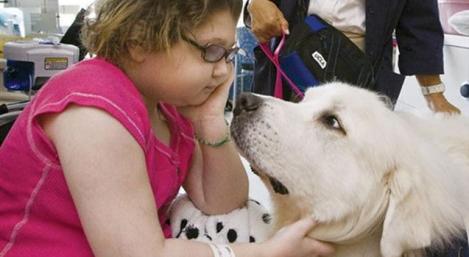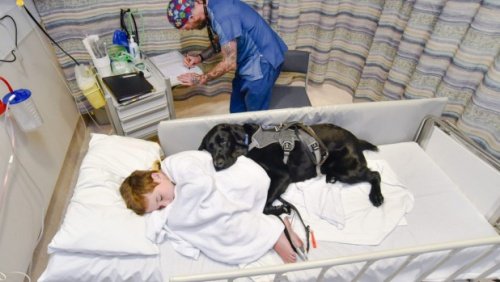How Do Therapy Dogs Help Hospitalized Children?

We all know how wonderful dogs are and how they make our lives easier, especially when life is hard. We have rescue dogs, police dogs, assistance dogs, guide dogs, and then therapy dogs — some of which are extra special and help hospitalized children.
We already know that whatever role they’re playing, dogs are always motivated by two things: loyalty and love. That’s why it’s not surprising that they are so effective at their jobs. Today, we’re going to talk about one very special job: therapy dogs helping hospitalized children.
Therapy dogs and kids

They say that everything is better with a dog, and we couldn’t agree more. Alicia does too. Alicia is an 8-year-old girl with attention problems. In fact, she can hardly concentrate on anything, but when she’s in the hospital in therapy and her good friend Ron the Labrador retriever comes in, Alicia turns into a whole new girl.
The connection between a child and a dog is hard to explain. It’s magic that just escapes our adult minds. Some people wonder how dogs can live with babies and not hurt them, even if the baby pulls its fur or sticks their hand into its mouth. We don’t really know how it works, but what do know is that sparks fly when dogs and children first meet.
That’s what the AAT (Assisted Animal Therapy) says. Animal assisted therapy is being used with children who have autism, selective mutism, intellectual disabilities, and cerebral palsy, among other conditions and diseases.
It’s not actually a new idea. Sigmund Freud, the inventor of psychoanalysis, always took his dog and loyal companion with him to sessions. Therapy with animals is still effective today. If your child has one of the health issues we mentioned, you’re probably wondering if AAT would be good for them. So read on and we’ll tell you all about it.
AAT and why therapy dogs are good for hospitalized children

- Mediator. This is the main role that therapy dogs will play: mediating between the doctor and your child. He’ll be like a bridge to facilitate communication between the two. This type of therapy by no means replaces traditional medicine, but it does help children express their feelings.
- Interaction. Many believe that having a dog at home is enough, but that’s not true. Merely being with a dog is not the same as animal assisted therapy. Therapy dogs go through exhaustive training and then do exercises with the child, a lot of times subtly so that they don’t even notice it’s therapy.
- It works for everyone. No matter what disorder the child has or how old they are, this type of therapy is great for everyone. Allergies and phobias are two exceptions, but otherwise therapy dogs can work for just about anyone.
- Motivation. Animal assisted therapy is designed to make children feel comfortable and relaxed, thus fostering a motivating environment where they feel they can express themselves.
- Your child will be happier. Almost all children enjoy being with animals. That’s why children come out of time spent with therapy dogs happier and encouraged. Despite how hard it is to be in a hospital, especially as a kid, they leave therapy feeling more motivated.
If you were on the fence about therapy dogs and animal assisted therapy, go ahead and get informed but we say there’s not much reason to hesitate: the benefits are many and the risks are few.
This text is provided for informational purposes only and does not replace consultation with a professional. If in doubt, consult your specialist.